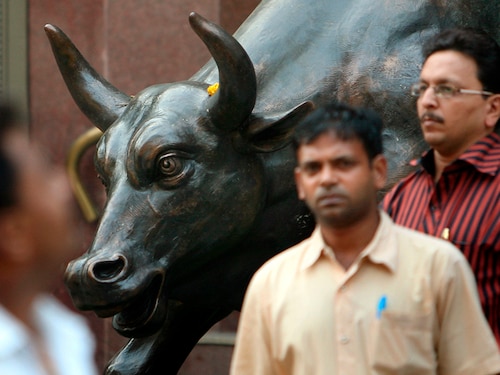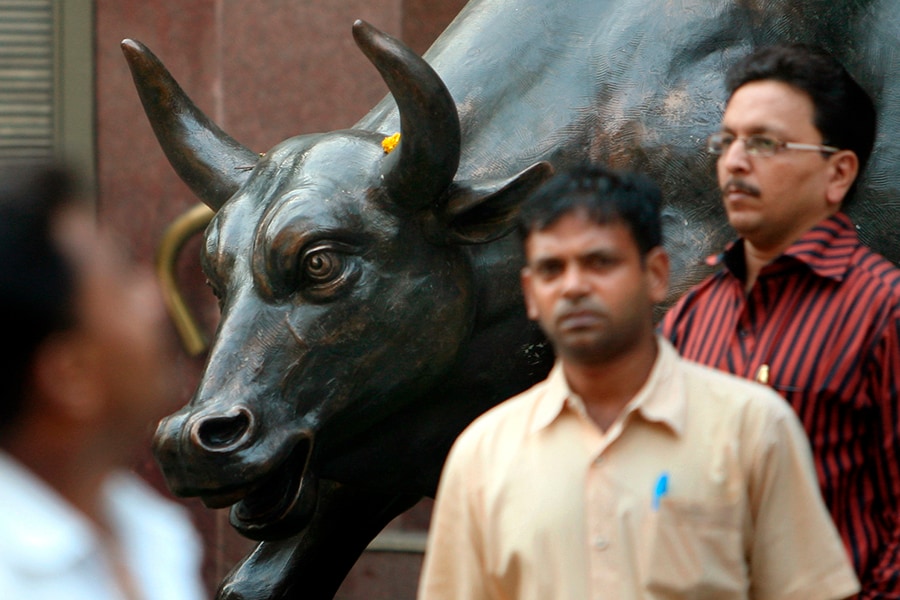Indian shares, rupee climb further, shrug off impact of US interest rate hike
Steady inflation, strong domestic growth story likely to keep equities firm


Image: Punit Paranjpe / Reuters (Image for illustrative purposes only)
India’s stock market indices ignored the potential impact of an interest rate hike which the US central bank which was announced earlier this week and continued to rally further to new lifetime highs on Friday. While the Nifty 50 had hit a high of 9,152.90 points on Thursday morning, it climbed further on Friday to a new intraday record high of 9,218.40 on Friday, before closing the week at a new lifetime close of 9,160.05 points.
The benchmark 30-share Sensex index has also continued to climb upwards, closing up 0.21 percent on Friday at 29,648.99. It is now just 1.25 percent from its all-time high of 30,025 struck on March 3, 2015.
India’s rupee also continues to rule firm against the US dollar at 65.48, making it one of the strongest performing currencies in the world, strengthening from 67.25 levels a year ago.
The US Fed on Wednesday had announced raising rates by 25 basis points – its second such move in three months – to a range of 0.75 percent to 1 percent, driven by factors such as improved jobs data, pace of growth and inflation getting closer to its expected target.
Theoretically, a US Fed rate hike often means certain knee-jerk concerns for emerging markets. Higher Fed rates could lead to the strengthening of the US dollar. It also implies that as the Fed rate goes higher, so will US bond yields, which will narrow the differential between EM and US bonds.
So what then makes investors into Indian equities so bullish at the moment? It’s a mix of factors. Firstly economists Forbes India spoke to say the Fed’s latest move had already been priced into our markets. Secondly, commentary from the US central bank was “not hawkish”, indicating that the US economy may not gallop away at a breathtaking speed. Thirdly, India’s most common economic concerns which relate to high inflation and current account/fiscal deficits are not worrisome factors.
This week, investors also cheered the Bharatiya Janata Party’s (BJP) emphatic state assembly election victories in Uttar Pradesh and Uttarakhand, results for which were announced last Saturday. These seemed to suggest greater scope for structural reforms.
K Shankar, CEO of Feedback Business Consulting, says: “The decibels will move from politics to decision making. Reforms will gather pace and investments will move beyond greenshoots. These results have fashioned a template of consistency in policy over the next decade. That is possibly the single biggest reassurance for businesses to boost the much needed capex cycle.”
While action from the US Fed was closely watched, (the hike) was also widely anticipated. “The action from the Fed was not a surprise,” says Siddhartha Sanyal, chief India economist at Barclays Plc. R Sivakumar, head (fixed income), Axis Mutual Fund, echoes a similar view.
"The (US Fed) commentary seems to suggest that it was not very optimistic about a strong pace of growth in the US in the coming year. Therefore, this goes against what the market is expecting. The market was expecting the Fed to upgrade its view on the economy," Sivakumar told Forbes India. “The market expectation was that the Fed would deliver a hawkish commentary and it went the other way. The Fed did not indicate that they are viewing the economy as running hot.”
The rupee has also moved up smartly against the dollar in recent months. What has often been seen is that when a developed economy performs well, emerging markets like India tend to outperform others. Emerging markets act as a leverage play on developed market growth and therefore, historically, when we have seen strong developed markets performance, flows to emerging markets have been strong and currencies performed well too.
The Indian rupee had weakened to the dollar between 2010 and 2013 and inflation in India was close to double digits while US inflation was much lower. But now the inflation differential is small and India’s balance of payments situation is strong. Sivakumar and Sanyal both expect the rupee to remain stable.
Domestically, India’s macroeconomic conditions appear to be sound. “Most of our usual concerns – high inflation, a current account and fiscal deficits – are not present. Economic activities are normalising recovering from the banknotes ban shock in November,” says Sanyal.
A few pockets of worries, such as high NPA levels for banks, sluggish private capex and weak credit growth, are present, but these are known worries. On the other hand, the recent election win by the ruling BJP can potentially energise the government’s drive to implement some of its key proposed reforms (ie, the Goods and Services Tax - GST).
The Reserve Bank of India (RBI) in its last policy on February 8 kept interest rates unchanged, with the repo rate at 6.25 percent. But the monetary policy committee (MPC) changed its policy stance to ‘neutral’ from ‘accommodative’, which suggests a lower possibility for a cut in interest rates in coming months.
The central bank has projected inflation at between 4 and 4.5 percent in the first half of FY18 and between 4.5 and 5 percent in the second half. MPC is committed to the 4 percent medium term target for inflation. Sivakumar said the RBI probably switched to the neutral stance too early, estimating that food inflation could rise in a year’s time.
Sanyal expects demand to bounce back in the coming fiscal year (2017-18) to 7.9 percent, compared to our forecast 7 percent (with further downside risks) for the current fiscal year ending March 31, 2017. Thus even while valuations are looking a little stretched, several global funds have increased allocations towards India.
First Published: Mar 16, 2017, 15:15
Subscribe Now